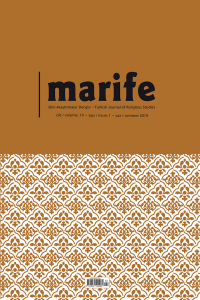
Marife Dini Araştırmalar Dergisi
Yazarlar: İ̇brahim SİZGEN, Nasi ASLAN
Konular:Din Bilimi
DOI:10.33420/marife.809253
Anahtar Kelimeler:Fiqh,Tillo,Madrasah,Mamdûhiyyah,Education
Özet: level in the historical course. Even though the madrasahs have been shut down officially with the Law of Unification of Education on March 3, 1924, especially in Southeastern Anatolia the traditional madrasah system continued its existence unofficially. With the Regulation on Courses for the Education and Training of the Quran published in the official newspaper dated 07/04/2012 and numbered 28257, the mentioned madrasas were connected to the Directorate of Religious Affairs and continued their education activities under the name of "Quran course". Just like in the other parts of the Turkey, one might find a madrasah in almost every city in Southeastern Anatolia. But when it comes to keeping the madrasah education systematic, the madrasas that are in the Tillo county of the city Siirt are the ones that come to mind. In Tillo, there are three madrasas that works in that way and they are; Mamdûhiyyah, Mujahidiyyah and Ismail Faqirullah madrasas. Tillo Mamdûhiyyah Madrasah has been established with the leadership of Sheyh Bedreddin Aydın whom also known as “Seydâ Sheyh” in the region. It is one of the educational institutions that raised a lot of scholars whom could answer all of the theological questions of the people as a result of the excellent Arabic education they received from the madrasah. This institution has lived through the rise in terrorist attacks in 1984 and incessant state of emergencies and the horrible February 28 period with such fortitude. It kept its existence with the sincere support of the locals and by avoiding political statements and actions during this period. In this article the concise history, institutional and physical structure, daily program and the place of fiqh lessons in the education curriculum and curriculum of the Mamdûhiyyah Madrasah in general are examined. The research is limited to Mamdûhiyyah Madrasah which still continues its educational activities. Interviews were made with the teachers regarding the fiqh program of the madrasa in question, and the fiqh books taught here were introduced in terms of content and context. The following points are the highlights of the study: For Tillo Mamdûhiyyah Madrasa there are two basic semesters called “fakihlik” and “tâliplik”. It is seen that during the first period, the lessons are mostly about Arabic grammer. After the pre-prepared reading list for this period is done the students move on to the second period and start following a more advanced curriculum. During this second period, logic, vaz’, kalam and usul al- fiqh are included in the curriculum and the students who goes through all of them are called “tâlip”. The student who is now called a tâlip is required to memorize al- Qâfiyah which is about syntax and Isagoge which is about logic. After a student completes the courses for both fakihlik and tâliplik periods in Mamdûhiyyah Madrasah, he gains the right to receive ijazah. Most of the students who obtain their ijazah stays in the madrasah for two more years and become experts on the fields of fiqh, tafsir, hadith, the life of prophet Muhammad. It is a known fact that almost all of the population in Southeastern Anatolia belong to the Shafi sect. As a result of this -though there are some exceptions- most of the books that are included in the madrasas’ curriculums are written by scholars who are also from Shafî sect. When the education and training curriculum of Tillo Memdûhiyye Madrasah, which is based on text memorization, opinion and negotiation method, is examined, it is seen that secondary fields such as, syntax, rhetoric and logic are emphasized. Even though this is an understandable way to provide a basis for further education in Islamic education, the lack of materials related to Fiqh, creed, tafsir, hadith and their methodology in the curriculum is an important downside of the madrasah. Considering the place of fiqh teaching in the curriculum, it is seen that it is not systematically included in the sequential courses and is limited to only a few major works as a minor course. As for usul-al Fiqh, it cannot be said that any books other than of Taceddin es-Subki’s Cem’u’l- cevâmi’ are included in the curriculum. Since the language of this work is difficult and hard to understand, most students in the madrasah read this work not to learn the fiqh method, but to complete the sequential books that must be taught in the madrasa to graduate. In this sense, it is seen that the field of fiqh couldn’t take its deserved place in the curriculum. Mamdûhiyyah Madrasah with its strong educational tradition and service, and hundreds of graduates have grown out of being local, gained a wide educational web by spreading most parts of Turkey. Today, most of the graduates of Tillo Memdûhiyyah Madrasah are imams, muezzin and Quran course instructors in the city center and villages under the Directorate of Religious Affairs.